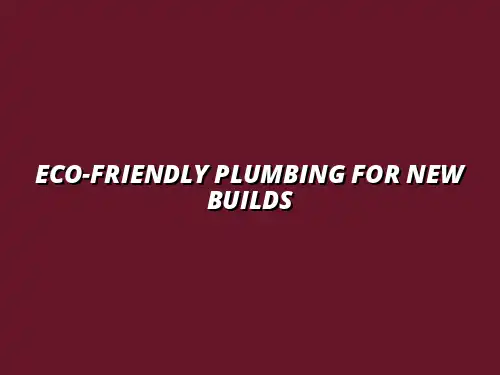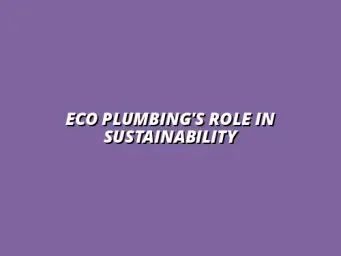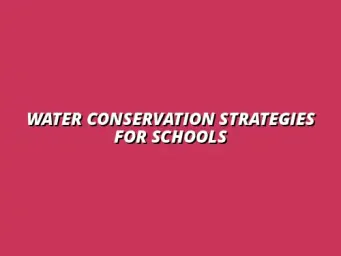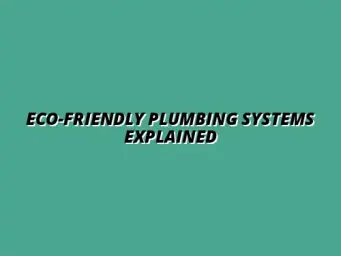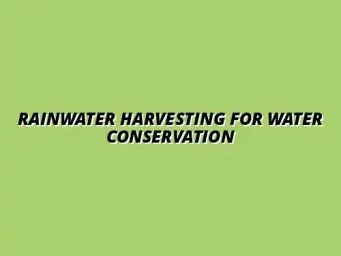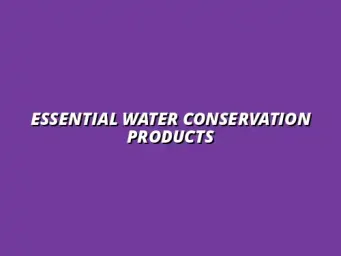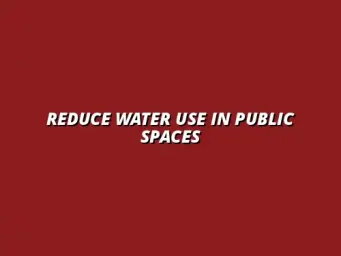Understanding Eco-Friendly Plumbing Solutions in New Construction
Eco-friendly plumbing solutions are becoming essential in modern construction. As our world faces environmental challenges, traditional plumbing methods can have detrimental impacts. From excessive water usage to energy inefficiencies, it's crucial to understand how sustainable practices can help mitigate these issues.
By adopting eco-friendly plumbing solutions, builders can significantly lower the environmental footprint of new constructions. These methods not only preserve our natural resources but also contribute to a healthier living environment. That’s why understanding these solutions is a vital step for anyone involved in the construction process! For homeowners, learning plumbing maintenance tips is also crucial for extending the life of their systems.
The Importance of Sustainable Plumbing Practices
Traditional plumbing methods can lead to unnecessary waste, with *millions of gallons of water lost each year* due to leaks and inefficient fixtures. This not only puts a strain on local water supplies but also results in higher utility bills for homeowners. In contrast, adopting sustainable plumbing practices can help reduce this impact and promote water conservation. Simple changes, like those outlined in this guide to water-saving tips, can make a big difference.
Moreover, eco-friendly plumbing practices often include energy-efficient technologies that lower energy consumption. Utilizing sustainable methods helps builders create structures that are not only cost-effective but also environmentally responsible. The benefits are clear: we can save money while protecting the planet!
- Reduces water waste
- Decreases energy consumption
- Promotes healthier living environments
- Potential cost savings on utility bills
Defining Eco-Friendly Plumbing Solutions
So, what exactly are eco-friendly plumbing solutions? At their core, these methods focus on *water conservation techniques, energy-efficient systems,* and the use of sustainable materials. This means that everything from the pipes to the faucets is designed with the environment in mind. Choosing the right materials is key, and this eco-friendly plumbing material guide can help.
Key components of eco-friendly plumbing include innovations like low-flow fixtures, which minimize water usage without sacrificing performance. Additionally, systems that incorporate *renewable resources*, like solar water heating, offer sustainable alternatives for homeowners. By integrating these practices, we can build not only efficient but also responsible plumbing systems!
- Low-flow faucets and showerheads
- Dual-flush toilets
- PEX and copper piping
- Solar water heating systems
Key Components of Eco-Friendly Plumbing Systems
To implement effective eco-friendly plumbing systems, it's essential to understand the key components that make them work. These include advanced fixtures, sustainable materials, and energy-efficient appliances. Each of these elements contributes to a plumbing system that is not only efficient but also environmentally friendly.
In new construction, integrating these components right from the start can lead to lasting benefits for homeowners and the environment. By focusing on these key elements, we can create a plumbing ecosystem that nurtures *sustainability and efficiency* in every home!
Water-Efficient Fixtures and Appliances
One of the main goals of eco-friendly plumbing is to reduce water consumption. Low-flow faucets and showerheads, for instance, use significantly less water while still delivering a strong performance. Dual-flush toilets provide an option for either a half or full flush, depending on the necessity. This can save a substantial amount of water over time! Knowing how to fix a leaky bathroom faucet can also prevent significant water waste.
In addition to faucets and toilets, many appliances now come with energy and water-saving features. Here are some examples of water-efficient fixtures and appliances:
- Low-flow showerheads
- High-efficiency washing machines
- Smart irrigation systems
- Water-saving dishwashers
Alternative Materials for Plumbing Systems
The materials used in plumbing systems also play a significant role in sustainability. Alternatives such as PEX (cross-linked polyethylene) have become popular due to their durability and resistance to corrosion. Copper is another excellent choice, as it is highly recyclable and lasts a long time.
Using recycled materials also minimizes waste and promotes sustainability. Here are some eco-friendly materials to consider when planning your plumbing system:
- PEX piping
- Copper pipes
- Recycled PVC
- Stainless steel fixtures
Choosing sustainable materials not only benefits the environment but can also lead to lower overall maintenance costs for homeowners! Regular water heater maintenance is another key aspect of eco-friendly plumbing.
Energy-Efficient Water Heating Options
Water heating can consume a significant amount of energy in a household. That's why opting for energy-efficient water heating solutions is crucial. Tankless water heaters, for instance, only heat water as needed, which can save energy and money.
Another great option is solar water heating systems. They harness the sun’s energy to heat water, making them an *excellent sustainable choice*. Additionally, heat pump water heaters are designed to transfer heat rather than generate it, offering another efficient alternative.
- Tankless water heaters
- Solar water heating systems
- Heat pump water heaters
- High-efficiency conventional water heaters
Rainwater Harvesting and Greywater Recycling
Implementing rainwater harvesting and greywater recycling systems is an excellent way to use water sustainably in new constructions. These systems allow homeowners to collect and reuse water from various sources, reducing the demand on municipal water supplies.
Rainwater harvesting typically involves collecting and storing rainwater from roofs, while greywater recycling recycles water from sinks, showers, and washing machines. This not only conserves water but can also lead to significant savings on water bills over time.
- Rain barrels for garden irrigation
- Greywater systems for toilet flushing
- Soakaway systems for stormwater management
- Filtration systems for safe reuse
Addressing Common Questions About Eco-Friendly Plumbing
What are the long-term benefits of eco-friendly plumbing solutions?
When considering eco-friendly plumbing solutions, the long-term benefits are truly significant. First and foremost, these solutions can lead to substantial cost savings on utility bills over time. By utilizing water-efficient fixtures and energy-saving systems, homeowners can enjoy lower monthly expenses, making eco-friendly choices economically wise!
Additionally, embracing these sustainable practices contributes to environmental conservation. By using less water and energy, we help preserve natural resources for future generations. It's a win-win situation for both your wallet and the planet! Learn more about the benefits of eco-friendly plumbing for homeowners.
- Reduced utility costs
- Minimized environmental impact
- Increased property value
How can homeowners evaluate eco-friendly plumbing options?
Evaluating eco-friendly plumbing options involves doing a bit of research and comparison shopping. Start by looking for products with energy efficiency ratings and certifications, such as the WaterSense label for faucets and toilets. These ratings indicate that the product meets specific standards for water conservation and energy efficiency.
Another key consideration is to compare the lifetime costs of different systems. Sometimes, a higher upfront investment in an eco-friendly product can lead to greater savings in the long run.
- Check for energy efficiency ratings
- Look for certified products
- Compare lifetime costs
Is eco-friendly plumbing suitable for all types of construction?
Yes! Eco-friendly plumbing solutions can be adapted for various construction types. Whether it's a single-family home, multi-family dwelling, or commercial building, there are sustainable options available for every project. Many builders are now recognizing that these solutions not only help the environment but also enhance the overall quality of the building.
For instance, eco-friendly plumbing systems can be integrated into both new builds and renovations. It's essential to evaluate the specific needs of the project and identify the best sustainable practices to implement. Finding a reliable plumber is crucial for successful installation.
- Single-family homes
- Multi-family dwellings
- Commercial buildings
Future Trends in Eco-Friendly Plumbing for New Construction
Innovative Technologies Shaping Sustainable Plumbing
The future of eco-friendly plumbing is bright, thanks to several innovative technologies! Smart plumbing systems are gaining traction, allowing homeowners to monitor water usage in real-time and detect leaks promptly. This technology not only contributes to sustainability but also saves money by preventing water waste.
Moreover, the integration of Internet of Things (IoT) technology is revolutionizing plumbing systems. Automated water management tools can optimize usage, ensuring that water is used efficiently throughout the home.
- Smart plumbing systems
- IoT integration
- Automated water management tools
The Growing Demand for Green Building Practices
We're witnessing a significant shift in the construction industry, with a growing demand for green building practices. More homeowners are becoming aware of the importance of sustainability and are seeking eco-friendly solutions for their projects. This trend is encouraging builders and contractors to prioritize environmentally responsible practices in their work.
The desire for sustainable living is also driving innovations in eco-friendly plumbing systems. As more people opt for these solutions, the construction industry is evolving to meet this demand!
- Increased awareness among consumers
- More builders adopting green practices
- Continuous innovation in plumbing technology
Final Thoughts on Eco-Friendly Plumbing Solutions
Encouraging Sustainable Practices in New Construction
As we conclude, it's clear that eco-friendly plumbing solutions play a vital role in modern construction. They offer numerous advantages, from cost savings to environmental benefits. By considering sustainable practices, we can collectively contribute to a healthier planet!
Emphasizing the importance of these solutions can drive change in the construction industry, paving the way for a more sustainable future. It's inspiring to think about how our choices today can positively impact the world tomorrow!
Next Steps for Homeowners and Builders
For homeowners and builders alike, taking the next steps toward eco-friendly plumbing is essential. Start by researching reliable products and systems suited for your specific needs. Consulting with professionals who specialize in sustainable practices can also provide valuable insights.
Most importantly, don’t hesitate to ask questions and seek guidance on how to implement these eco-friendly solutions in your projects. Together, we can make a meaningful difference!

